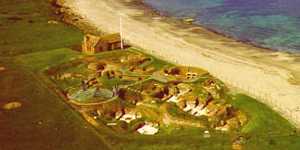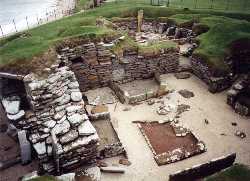

STONE AGE
BUILDING INDEX
STONE AGE
BUILDING
STANDING
STONES
NEWGRANGE
STONEHENGE
MALTA'S MEGALITHIC MARVELS
SKARA BRAE
HUNEBEDDEN
Skara Brae - A neolithic village
Looking around for remarkable Neolithic sites, I ran into Skara Brae: one of the best surviving examples of a Neolithic settlement.
Skara Brae, situated near the Bay of Skaill on Orkney's Mainland, is unique: it is a complete village with houses and streets. The houses are built closely together and made of stone. The spaces between the houses was filled with rubbish and turf for some kind of protection against the wind.
Skara Brae was found around 1850 after a huge storm had blown away it's sand coverage: for about 5 millennia she has been burried under the sand. It was this sand that not only protected her from being found, it also protected the village of erosion and decay. Skara Brae is remarkably well preserved!
 The site consists of several houses connected by passages. The village, older than the Egyptian pyramids and Stonehenge and of about the same age as the Maltese temples, was occupied from 3100 to around 2500 BC, during two distinct phases.
The site consists of several houses connected by passages. The village, older than the Egyptian pyramids and Stonehenge and of about the same age as the Maltese temples, was occupied from 3100 to around 2500 BC, during two distinct phases.
Of the earlier period two houses and some parts of other two are still visible. The later village, standing on the remains of the earlier, comprises six houses and a workshop. One of the best preserved buildings is House 1, which displays some of the most evocative features of Neolithic domestic life: opposite to the entrance is a remarkable stone dresser. Around it, a grinding stone and three small tanks set into the floor. Between the dresser and the central hearth, is a stone seat. On either side of the house are slab-built beds, with cupboards set into the walls.
 The furniture was made from local flagstone. All the houses have recesses, compartments and cells in the walls. Some of them, such of those behind the dressers, are not easily accessible. They were mainly used as storage spaces, but some cells, with drains running underneath them, could have been toilets.
The furniture was made from local flagstone. All the houses have recesses, compartments and cells in the walls. Some of them, such of those behind the dressers, are not easily accessible. They were mainly used as storage spaces, but some cells, with drains running underneath them, could have been toilets.
The houses, which measure from 4.3m x 4m to 6.4m x 6.1m, were probably roofed with timber, whalebone, turf and heather. The so-called workshop lies to the west of the village. It is a free-standing structure, with a central hearth but no household furniture. During excavation a lot of stones fractured by heat and fragments of chert were found. These finds suggest that it was a workshop for the making of stone tools.
A large amount of organic materials and artefacts were found and helped in giving an excellent picture of life in Neolithic times: among them some carved stone objects, probably used for ritual purposes, stone axes and a lot of bone tools (points, slices, mattocks) and jewels (pins, pendants and beads).
5,000 years ago the Bay of Skaill may have been much smaller, with more sand dunes and perhaps a freshwater loch behind the dunes. The village would have been behind this lagoon amid pasture much like exists today. Abandonment was very likely caused by encroaching sand, perhaps because of a great storm which set the sand dunes in motion and overwhelmed the village in a short time, as at the sands of Forvie more recently. However it continued in use for some time after this, as there were several occupation layers in the sand which filled the houses.
 What remains today is like an animal skeleton. There would have been driftwood available for furnishings and materials such as animal sheep skins, leather and eider down, as well as caisies, cubbies and the original Orkney chairs. There is no evidence of fabrics being used and no remains of anything to do with weaving. No spindles or whorls were found, so it is very unlikely that they could spin wool either.
What remains today is like an animal skeleton. There would have been driftwood available for furnishings and materials such as animal sheep skins, leather and eider down, as well as caisies, cubbies and the original Orkney chairs. There is no evidence of fabrics being used and no remains of anything to do with weaving. No spindles or whorls were found, so it is very unlikely that they could spin wool either.
The roofs could have been supported by couples made of driftwood or whalebones and been covered with skins or turf. There was probably a central hole as in a blackhouse to let out the smoke and let in some light. House 7 has holes in the top courses of stones which look like they are for the fitting of joists. As whales were much more abundant, strandings would have been more frequent 5,000 years ago. One blue whale ashore in the Bay of Skaill would have provided enough rafters for a village much bigger than this while the skin would have made an excellent roof covering!
 The soil conditions were not favourable for the preservation of wood and thus very little has survived. However there would have been plenty of driftwood from North America and it is very likely that wood was used for many purposes. The villagers must have had reasonably good boats to go fishing as they did. No doubt these craft had wooden frames with leather covering, while fishing lines could have been made from animal gut or sinews.
The soil conditions were not favourable for the preservation of wood and thus very little has survived. However there would have been plenty of driftwood from North America and it is very likely that wood was used for many purposes. The villagers must have had reasonably good boats to go fishing as they did. No doubt these craft had wooden frames with leather covering, while fishing lines could have been made from animal gut or sinews.
No evidence has been found of anything which could not have come from Orkney, suggesting a self-sufficient life-style. This does not exclude contacts with other groups, or even with Mainland Scotland, which can be seen from Sandwick. Boats good enough to fish off to the west of Orkney are certainly adequate to cross the Pentland Firth.
NEWGRANGE STONEHENGE MALTA'S MEGALITHIC MARVELS SKARA BRAE